What impact did the NDA's social schemes have?
A ground report from a nondescript Rajasthani village to assess how the government's schemes, such as the Swacch Bharat Mission, Jan Dhan Yojana and Ujjwala Yojana, have affected daily life in parts o
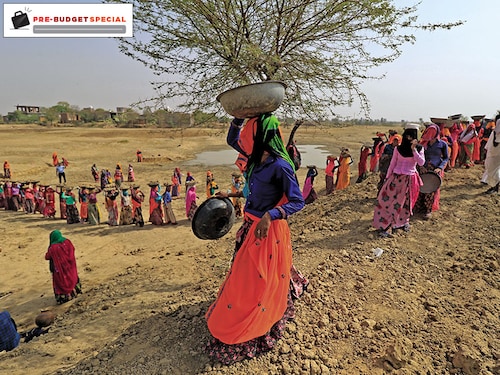

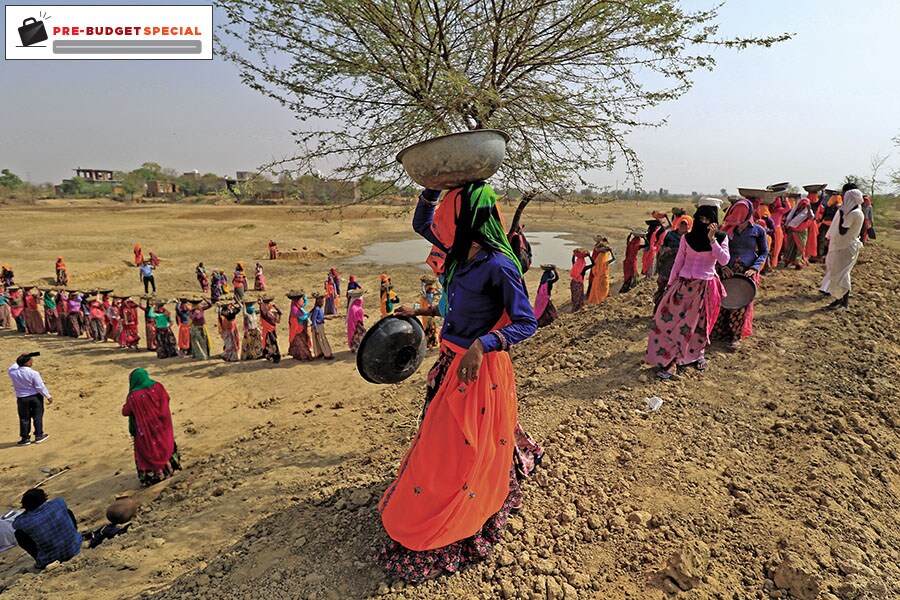 Under the MNREGA, an artificial lake is being dug in Moondiya to increase water levels
Under the MNREGA, an artificial lake is being dug in Moondiya to increase water levels
Image: Vishal Bhatnagar for Forbes India[br]In the nondescript village of Moondiya Kalan, 60 km away from Jaipur, Rajasthan, the sound of a dhol wasn’t a cause of celebration. Instead, it was an unusual way to embarrass people defecating in the open. The move seems to have worked. Almost 90 percent of the 221 families in the village have built a toilet inside their homes. This comes in the wake of the NDA government pushing its pet project, Swachh Bharat Mission, which promotes cleanliness and sanitation. Social welfare schemes such as the Pradhan Mantri Jan Dhan Yojana, Pradhan Mantri Awas Yojana and Pradhan Mantri Ujjwala Yojana among others have brought about a positive change in the lives of people in rural India in particular. Using Moondiya—located in the Todaraisingh sub-district of Tonk—as a test case, Forbes India assesses their impact.
Swachh Bharat Mission
As part of the scheme launched in 2014, each of the 221 families got ₹12,000 via direct transfers in their bank accounts to build toilets in their homes. The panchayat worked with officers of the mission to ensure there are 2-3 public toilets in the village. “It has been three years since we have a toilet inside the house. Prior to that, I would go to the fields near the jungle early morning or late at night. If someone came there, I would have to get up. Also, I would catch infections early,” says Nirmala Jahangir, a housewife with three children.
Humiliating people with dhols helped. “We needed to find the right way to change mindsets. No matter how many times we talked to them, nothing worked. We had to come up with an innovative way. So if we saw an individual going to the fields, we would embarrass them by playing the dhol and creating a scene… eventually they would have to use a toilet,” says Damodar Bairwa, district project coordinator, Swachh Bharat Mission.
The plan now is to have vans go around the village to collect waste to dump it the right way.  Swachh Bharat Mission: Launched as an awareness campaign in 2014 with the intention to clean up both urban and rural India. The focus is on sanitation, as well as solid and liquid waste management.
Swachh Bharat Mission: Launched as an awareness campaign in 2014 with the intention to clean up both urban and rural India. The focus is on sanitation, as well as solid and liquid waste management.
Image: Vishal Bhatnagar for Forbes India[br]Expectation: There has been a rapid expansion in building toilets and a number of villages have become free of open defecation. “Apart from this, installing systems that ensure appropriate solid and liquid waste management will be critical,” says Yamini Aiyar, president and chief executive, Centre for Policy Research.
Mahatma Gandhi National Rural Employment Guarantee Act (MNREGA)
In early June, with the temperature hovering around 45°C at 8 am, close to 40 women toil their way up a small hill with a basket filled with soil balanced on their colourful ghoonghats (veils). They empty their baskets and walk back to the designated work square on the barren land being dug up to from a man-made lake. “This is a MNREGA site, ma’am,” says Murli Meena, the sarpanch.
Most of the development in Moondiya has taken place under MNREGA—launched by the Congress-led United Progressive Alliance (UPA) government in 2005—be it creating lakes or cement roads. “[Earlier] The connectivity was terrible because we didn’t have strong budgets. During the monsoon, we have carried pregnant women on shoulders through water-logged areas because no car or motorbike could reach the hospital,” says Meena, adding that convincing people to donate their land to make roads is time consuming, especially when they don’t getting monetary benefits.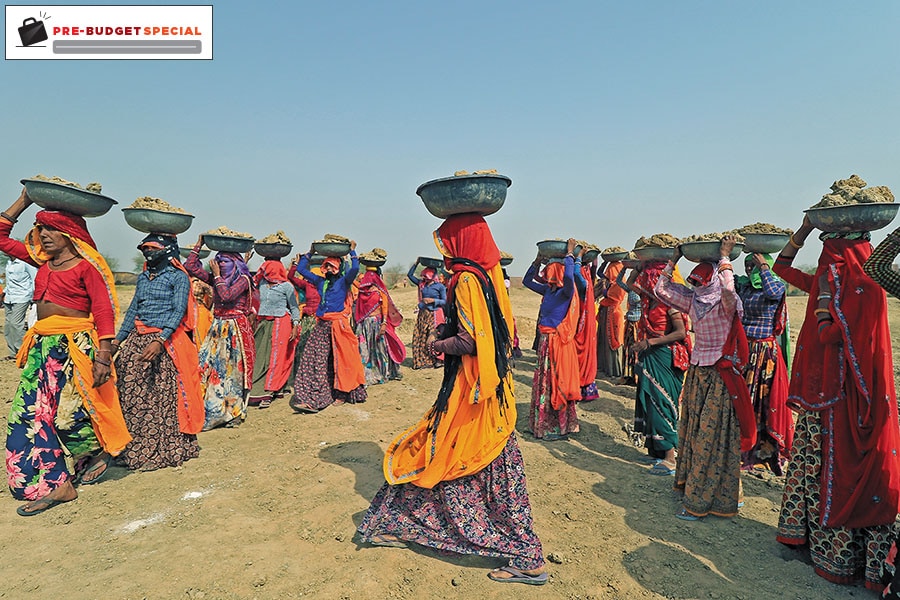 Mahatma Gandhi National Rural Employment Guarantee Act (MNREGA): Launched by the Congress-led UPA government in 2005 to provide employment to those in need, it guarantees the ‘right to labour’. In rural India, one of its objectives is to build strong rural assets.
Mahatma Gandhi National Rural Employment Guarantee Act (MNREGA): Launched by the Congress-led UPA government in 2005 to provide employment to those in need, it guarantees the ‘right to labour’. In rural India, one of its objectives is to build strong rural assets.
Image: Vishal Bhatnagar for Forbes India[br]The work site for MNREGA keeps shifting, depending on the work. Navneet Kumar, CEO, Tonk Zilla Parishad, says, “All panchayats need to have that one kind of work site [under MNREGA] ready so that if anyone asks for work, there is something available for them to earn.”
Work timings in summer have been slashed from 6 am to 1 pm instead of 4 pm. Depending on the soil that the women manage to remove, they get paid at the end of 15 days. Maina Devi, the wife of a farmer and mother to three children, got her job card under MNREGA when the scheme was just about taking off. “Our expenses are being taken care of. Dhoop mein taapte hai, toh paise aate hai (We toil in the heat to earn money),” she says.
Most of the labour works on MNREGA sites during summer when there is water scarcity and absence of farming. Almost all 1,177 villagers have a job card even if they are not working. “About 80 percent of the labour here is dependent on MNREGA for livelihood. Only when it rains, they go back to farming,” says Kumar.
The women get up to ₹199 each, depending on the quantity of materials carried. That’s less for the amount of efffort involved, says Devi. “We want good pay as there is no water and this is our only way to earn. My legs hurt because we have to walk almost 5 km one way in this heat.” Officials, however, say the amount is decided by the government. “We have to ensure that MNREGA doesn’t pay them more than what agriculture would, otherwise the sector would shut down,” says Kumar.
Expectation: Aiyar says MNREGA has a dual role: Function as a safety net by providing employment when needed and build strong rural assets. However, it is not without glitches. “There have been significant delays in payments. Reducing the delay and ensuring that wages are paid in full are critical to what needs to be done to fix MNREGA.” PM Ujjwala Yojana: The scheme was launched in May 2016 with an allocation of close to ₹8,000 crore. The focus was on distributing 5 crore LPG connections to below poverty line families.
PM Ujjwala Yojana: The scheme was launched in May 2016 with an allocation of close to ₹8,000 crore. The focus was on distributing 5 crore LPG connections to below poverty line families.
Image: Vishal Bhatnagar for Forbes India[br]Pradhan Mantri Ujjwala Yojana
The first thing one notices after entering Laduram and Nirmala Jahangir’s home is a chulha (traditional wooden cooking stove) lying unused in a corner. The walls have been freshly painted, but dark patches are evident due to the use of chulha over the years. Within seconds, Laduram, a carpenter, points to the one-year-old gas stove and LPG cylinder in the kitchen.
Nirmala says: “Cooking on the chulha was time consuming. I had to get firewood... Even making a cup of tea would take so much time. Sometimes the wood would burn up too fast and we had to use a fukani (blowpipe) to give it some air. My eyes would burn because of the smoke and I even got respiratory problems." Under the Pradhan Mantri Ujjwala Yojana, a family had to pay a one-time deposit of ₹1,500 for an LPG gas cylinder, a diary [to keep track of refills], pipe and a knob. That apart, every month they have had to pay between ₹500 and ₹700, of which they would get ₹200 as subsidy in their bank accounts. Each cylinder is given in the name of the head of the family and lasts for 1-2 months. “Here, 95 percent of the families have an LPG gas cylinder. Gas companies went door-to-door to get them to sign up for the Ujjwala Yojana. Even now, they can sign up for a cylinder online or via a text message,” says Ramvatar Chodhary, enforcement officer, Pradhan Mantri Ujjwala Yojana.
Expectation: According to the Petroleum Planning and Analysis Cell, the proportion of households with an LPG connection has increased from 56 percent in 2015 to 90 percent in 2019. However, refills often tend to be expensive and getting access to LPG gas cylinders is tough. Fixing these issues should be a priority.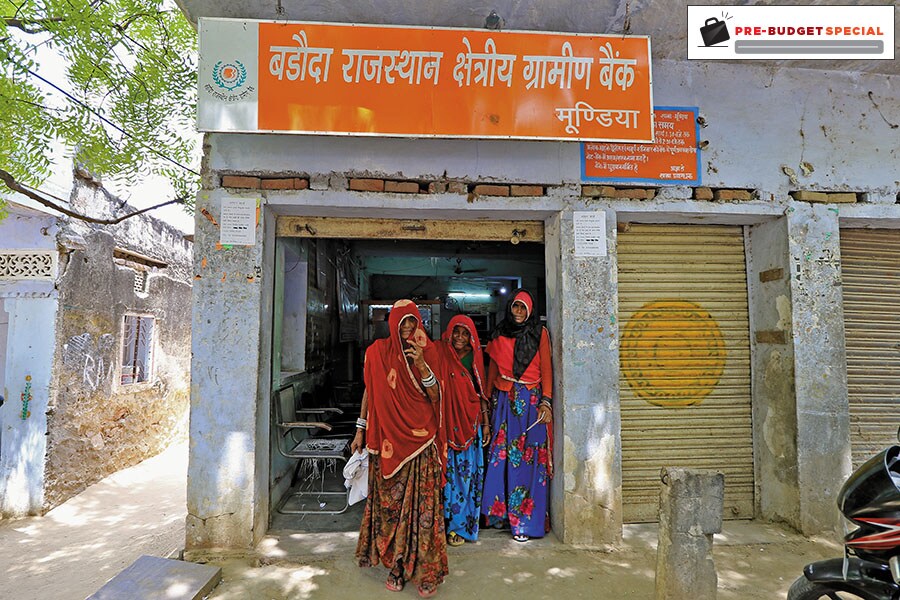 Pradhan Mantri Jan Dhan Yojana: The financial inclusion programme, launched in 2014, ensures that individuals aged between 20 and 65 have access to financial services and can set up bank accounts at zero balance.
Pradhan Mantri Jan Dhan Yojana: The financial inclusion programme, launched in 2014, ensures that individuals aged between 20 and 65 have access to financial services and can set up bank accounts at zero balance.
Image: Vishal Bhatnagar for Forbes India[br]Pradhan Mantri Jan Dhan Yojana
In a village bereft of striking structures, one is bound to notice a bright, orange-coloured board in a corner. What appears like a shop from afar is actually Moondiya’s only bank: A Bank of Baroda branch, which was set up in 1984. Unlike most spots in the village, it is crowded.
In 2014, the government launched the Pradhan Mantri Jan Dhan Yojana aimed at financial inclusion. This has ensured that every villager opens a bank account with zero balance. Suresh Kumar, branch manager, Bank of Baroda, says, “Convincing villagers to set up bank accounts at zero balance was easy. Since then, cash transactions have reduced drastically… whether it’s pension or wages from MNREGA, everything goes directly into their accounts.” At one time, one can withdraw up to ₹10,000 and deposit ₹20,000.
Times have changed, says Kumar. According to him, while women never frequented banks earlier, after the implementation of the Yojana, women seem to have taken control of operating bank accounts more than men.
Expectation: Although zero balance bank accounts have been set up, Aiyar hopes the government focusses on financial literacy in rural India. “Bringing the banks closer to houses would also help. Right now, banks are far from where the villagers live… hence making regular transactions is tough,” she says.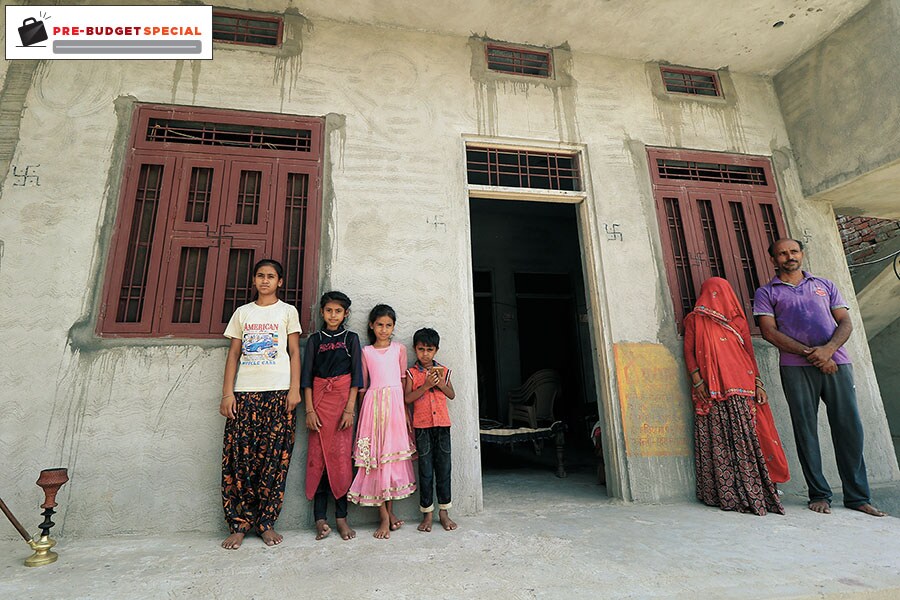 Pradhan Mantri Awas Yojana: Launched in 2015, it aims at providing affordable housing to the urban poor. The government has set a target of building 20 million affordable homes by March 2022.
Pradhan Mantri Awas Yojana: Launched in 2015, it aims at providing affordable housing to the urban poor. The government has set a target of building 20 million affordable homes by March 2022.
Image: Vishal Bhatnagar for Forbes India[br]Pradhan Mantri Awas Yojana
The house looked like it needed some work with one corner resembling a kachha ghar (mud house). A yellow-coloured board on the grey cemented walls read: ‘Pradhan Mantri Awas Yojana’. Ram Meena, a farmer who could build a 2 BHK under the scheme, stood outside with the pride of a homeowner. After pouring chilled cold drink in a glass, he opened the gallery on his smartphone. “This was our home till a year ago,” he says, pointing to a photo of an old mud house with a tin roof. “When it would rain, there would be water everywhere. We had five children… we didn’t know what to do,” says Meena.
Help came in the form of Pradhan Mantri Awas Yojana, which was launched in 2015 to provide affordable housing to the poor. As part of the scheme, a family gets ₹1.2 lakh in three installments. “They [beneficiaries] are given money depending on the progress of construction. The first installment comes when the ground level work is completed, second after the mid-level and the last after a roof is in place. At every level, a photograph is taken by the on-ground officer and uploaded to the portal. Once it is approved, the state releases the money in a week"s time,” says Birbal Meena, the officer for the yojana.
Since 2016-17, 23 houses in the village have benefitted from the scheme. A survey is conducted to take stock of people who have no homes, those who have kaccha ghars or a mix of both kaccha and pakka (cement) ghars before they can avail of its benefits. Murli Meena, the sarpanch, agrees that it is a time-consuming process, “It takes about five to six years to get approvals. This year, another survey was done, and there are 100 names on the list.”
Officials point out that the problem is that families make houses bigger than the promised size, and run out of money. As a result, many properties are still incomplete. And when they don’t have enough money, they add tin roofs. “We cannot permit that. It has to be a brick roof, so their third installment doesn’t get sanctioned and work gets stuck,” explains Birbal Meena.
The Pradhan Mantri Awas Yojana can be useful if processes speed up. As Ram Meena says, “Yeh ghar banaate banaate itne saal lag gaye, kay mere pitaji bhi marr gaye (It took so many years to build this house that even my father passed away).”
Expectation: The major issue with the scheme is targetting the right people. Currently, the list for the Yojana is drawn up based on the Socio Economic Caste Census (SECC) of 2011. It is vital for the government to make the SECC more dynamic and regularly update it, so that the right people benefit from the scheme.
Work in progress
Moondiya continues to struggle when it comes to agriculture. Most farmers are clueless about the Pradhan Mantri Kisan Samman Nidhi [under which small and marginal farmers who have less than 2 hectares of landholding get up to ₹6,000 per year as minimum income support]. Considering the water scarcity in Rajasthan, such policies are desperately needed. About 29 lakh farmers across Rajasthan have applied for the scheme. Says Aiyar, “Given the declining agriculture income, substantively strengthening MNREGA will be key because the framework already exists.”
While the implementation of many of these schemes has happened at an accelerated pace, the challenge for the government is to go beyond them and ensure that their purpose has been met. “There is a lot of clutter in the way we have implemented social welfare policies. We have over 400-500 schemes… these need to be rationalised so that they address core issues and get implemented effectively,” says Aiyar.
First Published: Jun 26, 2019, 11:30
Subscribe Now